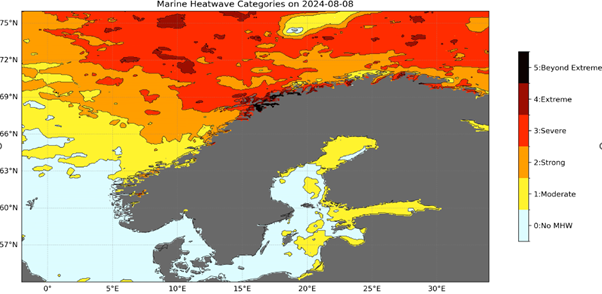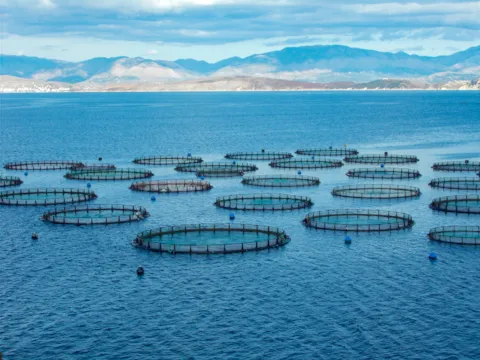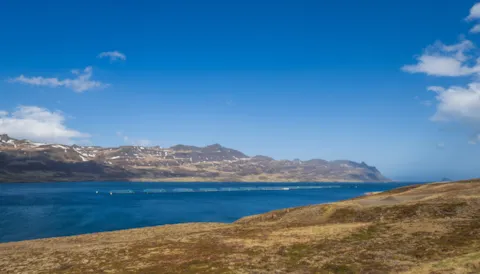Why temperature forecasting matters – and why now
When you plan your week, you probably check the weather forecast. In the same way, maritime industries increasingly rely on ocean temperature forecasts to plan and protect their operations.
Ocean temperature is more than just a number. It drives ocean density, stratification, oxygen levels, sea level rise, and ecosystem health. It shapes the risks of sea lice in aquaculture, the strength of storms affecting shipping routes, and the stability of offshore energy infrastructure.
With marine heatwaves becoming more frequent, intense, and prolonged, the ability to look ahead is no longer optional – it’s critical for resilience, efficiency, and sustainability.
Why now?
The ocean has always been variable, but climate change is accelerating and intensifying that variability. For industries operating at sea or along coasts, this translates into new risks that can impact both daily operations and long-term investments.
There are three main reasons why temperature forecasting has become essential right now:
- Climate variability is increasing risk
Ocean heatwaves, once considered rare, are now a recurring challenge. Elevated sea temperatures reduce oxygen levels, stress marine life, and speed up the development of harmful organisms such as sea lice in aquaculture. For offshore industries, this can mean disrupted schedules, higher mortality rates, or unforeseen costs.
- Stricter regulatory and market expectations
Regulators, investors, and certification schemes increasingly expect operators to use data-driven insights to demonstrate responsible management of environmental risks. Temperature forecasting provides a transparent, scientific basis for decisions that support sustainability goals and compliance.
- Expansion of coastal and offshore activities
Growth in aquaculture, offshore energy, coastal infrastructure, and shipping means more human activity in zones where complex ocean dynamics can influence success. Accurate, high-resolution forecasts are needed to manage safety, environmental impact, and operational efficiency.
Lessons from aquaculture
Aquaculture offers a clear example of how temperature forecasting can make a measurable difference. Salmon farming, for instance, faces major challenges from sea lice infestations that thrive in warmer waters. Treatments are costly and stressful for fish, and poorly timed interventions can reduce survival rates or limit growth.
By using short-term temperature forecasts, farmers can better plan the timing of treatments, minimizing both risk and cost. Seasonal forecasts can help in allocating resources and scheduling production cycles, while long-term projections provide insights into where operations may face growing environmental challenges in the future.
This same approach, combining near-term forecasting with long-range planning, applies equally well to other industries, from offshore wind construction to shipping logistics.
How DNV and Åkerblå Group supports industry
At DNV and Åkerblå, we deliver temperature forecasting across multiple time horizons, ensuring decision-makers have the right information when they need it most:
- 7-day forecasts to support operations and daily planning. These are particularly relevant for aquaculture, vessel scheduling, or offshore operations that depend on stable conditions.
- Seasonal predictions to support risk management and resource planning over months. This helps companies anticipate risks during warmer periods when disease pressure or storm activity may be higher.
- Yearly projections under IPCC climate scenarios to support long-term strategy and investment decisions. These projections enable operators to assess climate-related risks to sites, infrastructure, or supply chains decades into the future.
Our competence builds on scientific expertise, validated site-specific modelling, and decades of experience along the Norwegian coast – one of the world’s most advanced aquaculture regions.
Already, our forecasting tools have supported aquaculture operations in pre-planning sea lice treatments, ensuring interventions are both timely and effective. This reduces unnecessary stress on fish populations, improves animal welfare, and supports profitability for producers.

Figure: Analysis and illustration of marine heatwaves in August 2024. © Jie Liu, all rights reserved by Oceanography department, SCPA Åkerblå Group
The science behind forecasting
Ocean forecasting is a complex science that combines satellite data, oceanographic measurements, and sophisticated numerical models.
- Satellite observations track sea surface temperature trends on a large scale.
- Local measurements provide detailed, site-specific insights into conditions below the surface.
- Numerical models integrate this data, simulating how temperature and related variables (oxygen, salinity, currents) will evolve in the coming days, months, or years.
Marine heatwaves in recent years have shown just how powerful this science can be in protecting industry interests. For example, a 2024 heatwave in northern Norway was linked to record sea lice outbreaks, severely impacting salmon farms. Research published in Communications Earth & Environment (2025) highlighted the drivers of this event and underscored the importance of robust forecasting to anticipate such challenges (Gonzalez et al., 2025).
By integrating forecasting into decision-making, industries can move from reactive crisis management to proactive risk reduction.
Building resilience at sea
DNV’s role is to transform scientific insights into trusted decision support. Independence, cross-sector knowledge, and scientific credibility allow us to provide forecasts that customers can rely on when making complex choices.
From aquaculture operators scheduling treatments, to offshore wind developers timing installation work, to shipping companies optimizing routes, and coastal infrastructure managers preparing for heat-related stressors – temperature forecasting provides a reliable, data-driven foundation for building resilience in an uncertain climate.
Looking forward
The ocean is changing and industries must change with it. Temperature forecasting is not simply about predicting tomorrow’s conditions; it’s about supporting smarter, more sustainable operations across aquaculture, offshore energy, shipping, and beyond.
By combining deep scientific expertise with industry understanding, DNV is helping customers anticipate risks, protect assets, and create more sustainable value from the ocean.
10/6/2025 7:00:00 AM





